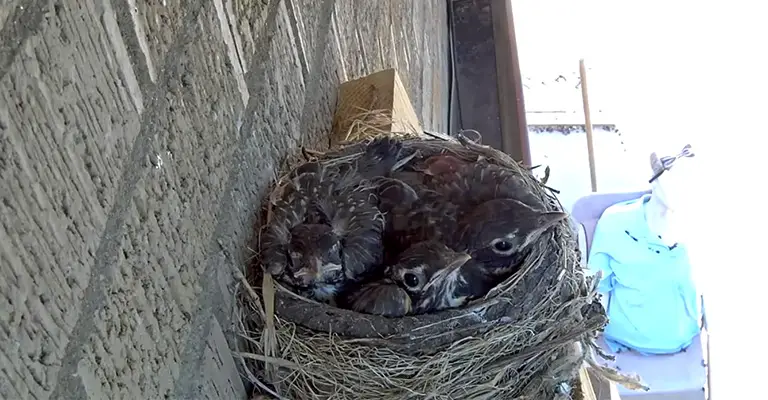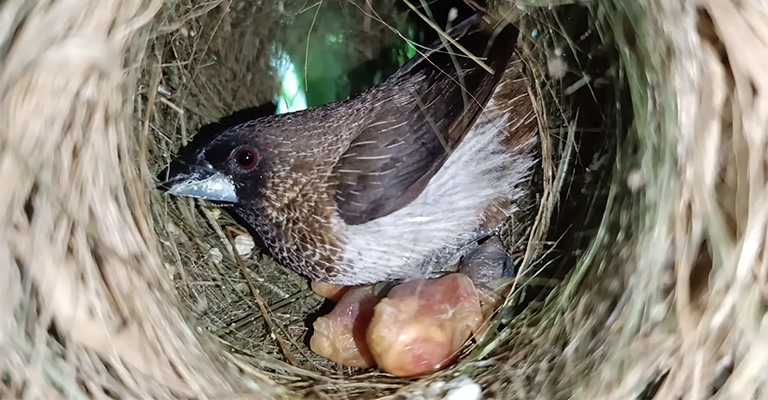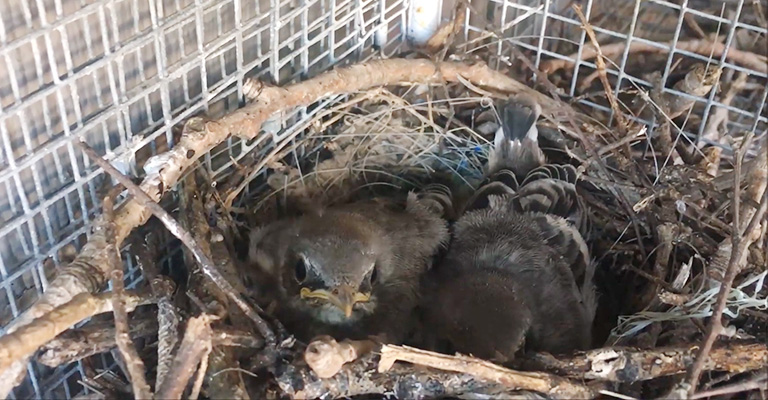Having birds take up residence in your attic can be an unwanted and challenging situation. The cozy shelter and seclusion that attics provide make them attractive nesting spots for various bird species.
However, the presence of birds in your attic can lead to structural damage, health risks, and disturbance. Finding effective and humane methods to get birds out of your attic is essential for both your property’s well-being and the birds’ welfare.
In this guide, we will explore how to get birds out of the attic to safely encourage the departure of these avian guests and prevent their return.
From identifying entry points to implementing noise deterrents and creating alternative nesting spots, understanding these methods will help you navigate the process of restoring your attic to a safe and peaceful space.

How To Get Birds Out Of The Attic? [9 Effective Methods]
Birds can be a nuisance and a health hazard when they nest in your attic. They can cause noise, damage, and diseases.
Here are some methods you can try to get rid of them safely and humanely.
Seal Off The Attic
The first step is to prevent the birds from entering your attic in the first place. You can do this by inspecting your roof, walls, vents, and windows for any gaps or holes that the birds can use as entry points.
You can then seal them with caulk, mesh, or netting. This will also help you save energy and prevent other pests from invading your attic.
Open The Windows
If you have windows in your attic, you can use them to let the birds out. You can do this by turning off the lights in the attic and opening the windows during the day.
The birds will be attracted to the natural light and will fly out of the windows. Once they are gone, you can close the windows and make sure they are secured.
Relocate The Nests

If you find any nests in your attic, you can try to relocate them to a nearby tree or shrub. You should do this when the adult birds are away from the nest, looking for food.
You should also wear protective gear and gloves to avoid contact with the nest materials, which may contain parasites or diseases.
You can gently move the nest with a shovel or a cardboard box and place it in a safe location where the parent birds can find their young.
Set A Trap
If you have a stubborn bird that refuses to leave your attic, you can use a trap to capture it and release it outside.
There are different types of traps available, such as cages or nets that can catch the bird without harming it.
You can bait the trap with seeds or bread crumbs and place it near the bird’s activity area. Once you catch the bird, you can take it outside and let it go.
Use Sound
Another way to scare the birds away from your attic is to use sound devices that emit loud noises or predator calls.
You can use a music player, a radio, or a speaker to play sounds that will annoy or frighten the birds, such as rock music, sirens, hawks, or owls.
You can also make your own noises by banging pots and pans or clapping your hands.
Use smell
Birds have a sensitive sense of smell, and they dislike certain odors that humans may find pleasant or harmless.
You can use essential oils, such as peppermint, lavender, or eucalyptus, to create a smell barrier that will repel the birds from your attic. You can spray the oils around the attic or soak cotton balls or rags in them and place them near the bird’s entry points.
Use Taste
Similarly, birds have different taste preferences than humans, and they avoid spicy or bitter foods that we may enjoy. You can use substances like cayenne pepper, garlic, vinegar, or lemon juice to deter the birds from your attic.
You can sprinkle these substances on the bird’s food sources or on their nesting materials.
Use Visual Deterrents
Birds are also scared of shiny or moving objects that reflect light or create shadows.
You can use visual deterrents like shiny tape, foil balloons, mirrors, CDs, or wind chimes to create an unpleasant environment for the birds in your attic.
You can hang these objects from the ceiling or near the windows to catch the bird’s attention and make them feel uncomfortable.
Use Decoys
Another option is to use decoys of predators that prey on birds, such as owls, hawks, foxes, or cats. You can buy realistic-looking decoys from stores or online and place them in your attic where the birds can see them.
This will make them think that there is a danger in your attic, and they will avoid it.
Why Birds Love Your Attic?

Birds are often drawn to attics for various reasons, as these spaces provide them with shelter, warmth, and nesting opportunities.
Understanding these factors can help you address the issue effectively:
Protection from Predators
Attics offer birds a safe haven from ground-based predators like cats and foxes. The elevated location and enclosed space make it challenging for these predators to access, making attics an appealing option for roosting and nesting.
Warmth and Shelter
Attics provide insulation from the elements, offering birds protection from cold temperatures, rain, and wind.
The warmth generated by the house below can create a cozy environment that attracts birds seeking a comfortable place to rest.
Nesting Opportunities
Many bird species are drawn to attics as potential nesting sites. The dark and secluded nature of attics mimics the natural nesting environment, making it an attractive location for raising their young.
Lack of Disturbance
Attics are typically undisturbed by human activity, which appeals to birds that prefer quiet and secure places to rest.
The constant comings and goings in other parts of the property can be disruptive to nesting birds.
Easy Access
Small openings or gaps in roofs, vents, or eaves can serve as convenient entry points for birds. These access points are often hidden from view and provide birds with a straightforward route into the attic.
Close to Food Sources
If your property provides a readily available food source, such as bird feeders or fruit-bearing trees, birds may be drawn to the attic to establish a nesting site nearby.
Urbanization and Habitat Loss
As urban areas expand and natural habitats shrink, birds may adapt to human structures like houses and attics to find suitable places to roost and nest.
Consistent Environment
Attics provide a stable environment with less fluctuation in temperature compared to the outdoors. This stability is particularly attractive to birds during breeding and nesting seasons.
Camouflaged Nesting Sites
The architecture and materials of attics can resemble natural nesting sites for certain bird species.
Birds that typically nest in tree cavities or crevices might find attics to be similar and suitable alternatives.
Adaptable Nature
Birds are known for their adaptability, and they can quickly learn to take advantage of available spaces that meet their needs.
Attics can fulfill these needs, making them an attractive option for various bird species.
To effectively discourage birds from taking up residence in your attic, it’s essential to address these factors by using humane deterrents and sealing off potential entry points while providing alternative nesting sites in safer locations.
Reasons for Removing Birds From Attic

Removing birds from your attic is crucial for several reasons, as their presence can lead to various health, safety, and property-related concerns.
Here are the reasons explained in more detail:
Health Risks
Bird droppings can carry harmful bacteria, fungi, and parasites that pose health risks to humans.
The accumulation of droppings in the attic can lead to the spread of diseases like histoplasmosis, which can cause flu-like symptoms or even more severe respiratory issues.
Structural Damage
Birds can cause structural damage to your attic and home. They often build nests using materials that can block vents and air passages, leading to poor ventilation.
Additionally, the acidic nature of bird droppings can corrode building materials over time, potentially weakening the integrity of your property.
Fire Hazards
Birds are known to collect flammable materials for their nests, and if they build nests near electrical wiring or fixtures, there is a risk of fire.
Nests lodged in or near electrical components could spark fires, leading to serious property damage or even danger to inhabitants.
Noise and Disturbance
Bird activity in the attic can be noisy, causing disturbances that disrupt your daily life and sleep.
The constant fluttering, chirping, and scratching sounds can be quite bothersome, affecting your quality of life.
Allergens and Irritants
Bird feathers, dander, and droppings can release allergenic particles into the air, potentially causing allergic reactions in sensitive individuals.
These particles can exacerbate respiratory issues, especially in those with asthma or allergies.
Insect Infestations
Nests in the attic can attract insects, parasites, and mites that feed on bird debris and nesting materials.
This can lead to secondary pest infestations that are challenging to manage.
Property Devaluation
The presence of birds and the associated damage they cause can lower the value of your property. Potential buyers or tenants may be deterred by the structural issues, mess, and potential health risks linked to bird infestations.
Legal Concerns
Depending on your location and the bird species involved, there may be legal protections for certain bird species and their nests. Removing them without proper authorization can lead to legal consequences.
Ethical Considerations
Allowing birds to inhabit your attic might seem harmless, but it can disrupt their natural behavior and survival patterns. Birds might become dependent on an environment that’s not suitable for their long-term well-being.
Prevent Future Infestations
If you don’t address the issue promptly and thoroughly, birds may return to your attic year after year, exacerbating the problems and making removal more challenging over time.
Given these reasons, it’s essential to take appropriate measures to safely and humanely remove birds from your attic, address any damage caused, and prevent their return by sealing off entry points and creating less attractive roosting and nesting environments.
FAQ
Listen for scratching or chirping sounds, and look for droppings or nesting materials. Check for openings that birds might use to enter your attic, such as gaps in the roof, vents, or eaves.
It’s recommended to do this during the late afternoon or early morning when the birds are more likely to be out foraging. This minimizes the risk of trapping adult birds away from their young.
Yes, several methods are humane and effective. These include installing vent covers, using noise or visual deterrents, and creating alternative nesting sites away from your attic.
If the nests are empty, it’s best to remove them to discourage birds from returning. However, if nests have eggs or chicks, wait until they’ve fledged and left the nest to avoid causing harm.
If the problem persists, consider seeking professional help. Wildlife experts can assess the situation, safely remove the birds, and offer guidance on preventing future infestations while ensuring the birds’ well-being.
Conclusion
Successfully getting birds out of your attic requires a combination of patience, understanding, and proactive measures.
By addressing the factors that attract birds to your attic and implementing humane techniques, you can ensure a positive outcome for both you and the birds.
Remember that the key is to discourage their presence without causing harm, respecting the creatures that share our environment.
Regular inspections and timely action will prevent potential damage to your property and help maintain a harmonious living space.
As you embark on this endeavor, the knowledge gained from these methods will empower you to effectively address bird infestations and create an attic that remains free from the disruptions caused by these feathered visitors.